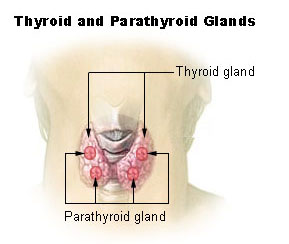Primary hyperparathyroidism: Difference between revisions
| Line 42: | Line 42: | ||
===Surgery=== | ===Surgery=== | ||
===Future therapies=== | ===Future therapies=== | ||
Revision as of 17:29, 20 September 2012
For patient information click here
| Primary hyperparathyroidism | |
 | |
|---|---|
| Thyroid and parathyroid. | |
| ICD-10 | E21.0 |
| ICD-9 | 252.01 |
| DiseasesDB | 6283 |
| MeSH | D049950 |
Template:Primary hyperparathyroidism Editor-In-Chief: C. Michael Gibson, M.S., M.D. [1]
Overview
Primary hyperparathyroidism causes hypercalcemia (elevated blood calcium levels) through the excessive secretion of parathyroid hormone (PTH), usually by an adenoma (benign tumors) of the parathyroid glands. Its incidence is approximately 42 per 100,000 people. It is almost exactly three times as common in women as men.
Signs and Symptoms
The signs and symptoms of primary hyperparathyroidism are those of hypercalcemia. They are classically summarized by the mnemonic "stones, bones, abdominal groans and psychic moans".
- "Stones" refers to kidney stones, nephrocalcinosis, and diabetes insipidus (polyuria and polydipsia). These can ultimately lead to renal failure.
- "Bones" refers to bone-related complications. The classic bone disease in hyperparathyroidism is osteitis fibrosa cystica, which results in pain and sometimes pathological fractures. Other bone diseases associated with hyperparathyroidism are osteoporosis, osteomalacia, and arthritis.
- "Abdominal groans" refers to gastrointestinal symptoms of constipation, indigestion, nausea and vomiting. Hypercalcemia can lead to peptic ulcers and acute pancreatitis.
- "Psychic moans" refers to effects on the central nervous system. Symptoms include lethargy, fatigue, depression, memory loss, psychosis, ataxia, delirium, and coma.
- Left ventricular hypertrophy.[1]
Other signs include proximal muscle weakness, itching, and band keratopathy of the eyes.
Diagnosis
The diagnosis of primary hyperparathyroidism is made by blood tests. Serum calcium levels are elevated.
Complications
The classic bone disease in hyperparathyroidism is osteitis fibrosa cystica, which results in pain and sometimes pathological fractures. Other bone diseases associated with hyperparathyroidism are osteoporosis, osteomalacia, and arthritis.
Treatment
Treatment is usually surgical removal of the gland(s) containing adenomas.
Medications
Medications include estrogen replacement therapy in postmenopausal women and bisphosphonates. Bisphosphonates may improve bone turnover.[2]
Surgery
Future therapies
Future developments such as calcimemetic agents (e.g. cinacalcet) which activate the parathyroid calcium-sensing receptor may offer a good alternative to surgery.
Related Chapters
References
- ↑ Stefenelli T, Abela C, Frank H; et al. (1997). "Cardiac abnormalities in patients with primary hyperparathyroidism: implications for follow-up". J. Clin. Endocrinol. Metab. 82 (1): 106–12. PMID 8989242.
- ↑ Khan AA, Bilezikian JP, Kung AW; et al. (2004). "Alendronate in primary hyperparathyroidism: a double-blind, randomized, placebo-controlled trial". J. Clin. Endocrinol. Metab. 89 (7): 3319–25. doi:10.1210/jc.2003-030908. PMID 15240609.